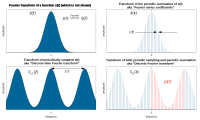
Photo from wikipedia
This paper is centred on the spectral study of a random Fourier matrix, that is an $$n\times n$$ n × n matrix A with ( j , k ) entries… Click to show full abstract
This paper is centred on the spectral study of a random Fourier matrix, that is an $$n\times n$$ n × n matrix A with ( j , k ) entries given by $$\exp (2i\pi m Y_j Z_k)$$ exp ( 2 i π m Y j Z k ) , where $$Y_j$$ Y j and $$Z_k$$ Z k are two i.i.d sequences of random variables and $$1\le m\le n$$ 1 ≤ m ≤ n is a real number. When the $$Y_j$$ Y j and $$Z_k$$ Z k are uniformly distributed on a bounded symmetric interval, this may be seen as a random discretization of the finite Fourier transform, whose spectrum has been extensively studied in relation with band-limited functions. Moreover, this particular case of random finite Fourier matrix has been proposed in wireless telecommunication in order to approach the singular values of some channel fading matrices. We first compare in the $$\ell ^2$$ ℓ 2 -norm, the spectrum of the matrix $$A^*A$$ A ∗ A with the spectrum of its associated integral operator. We show that the classical methods of concentration inequalities for kernel random matrices are well adapted for the spectral analysis of random Fourier matrices. We then concentrate on uniform distributions for the laws of $$Y_j$$ Y j ’s and $$Z_k$$ Z k ’s, for which the integral operator is the well-known Sinc-kernel operator with parameter m . We translate to random Fourier matrices the knowledge that we have on the spectrum of this operator. In particular, we study some asymptotic and non-asymptotic behaviours of the set of the eigenvalues of $$A^*A.$$ A ∗ A . This study is done in the spirit of recent work on the Sinc-kernel integral operator. As applications, we give fairly good approximations of the number of degrees of freedom, as well as an estimate of the capacity of a MIMO wireless communication network approximation model. Finally, we provide the reader with some numerical examples that illustrate the theoretical results of this paper.
Journal Title: Journal of Fourier Analysis and Applications
Year Published: 2017
Link to full text (if available)
Share on Social Media: Sign Up to like & get
recommendations!